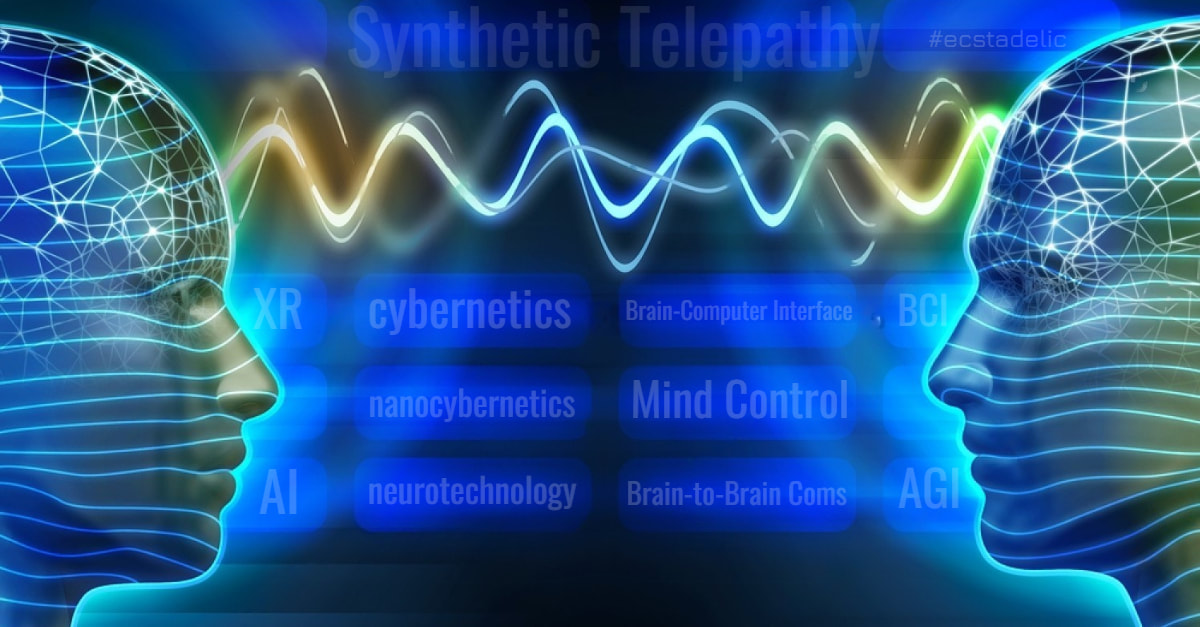|
by Elizabeth Titovskaya [Posted March 23, 2023 07.00 am PST] In recent years, the concept of synthetic telepathy has gained increasing attention from both the scientific community and the general public. The ability to communicate with others using only our thoughts may sound like something straight out of science fiction, but recent advancements in neuroscience and technology have brought us closer to making this a reality. Join us for an exclusive interview with futurist and evolutionary cyberneticist Alex M. Vikoulov, as he shares his expertise on the fascinating topic of synthetic telepathy. Speaking with news reporter Blanca Elena Reyes, Vikoulov will delve into the workings of this cutting-edge technology and discuss its potential applications for the future. Blanca Elena Reyes: Are you familiar with synthetic telepathy? If you do, how does it work? Alex Vikoulov: Synthetic telepathy, also referred to as neurotechnology, brain-computer interface (BCI), and more broadly, cybernetics, is a form of technology that enables direct communication between the brain and an external device without the need for physical intervention. This technology allows individuals to transmit their thoughts, feelings, and sensations wirelessly to another person or a machine, allowing for real-time communication and control of technology. The concept of synthetic telepathy and cybernetics in general has been around since the early 20th century, with early research focusing on understanding the electrical activity of the brain and how it can be used to control external devices. In recent years, advances in technology have made it possible to develop more sophisticated and accurate brain-computer interfaces, leading to the development of several applications, including communication aids for people with disabilities and remote control of robotic devices. The technology behind synthetic telepathy involves the use of electrodes or other sensors that are placed on the scalp or implanted directly into the brain to detect the electrical signals produced by the brain. These signals are then amplified, processed, and transmitted to an external device, such as a computer or a smartphone. The device can then interpret these signals and translate them into meaningful commands or messages, such as controlling a wheelchair or typing on a computer. One of the most promising applications of synthetic telepathy is in the field of medicine, where it has the potential to revolutionize the treatment of neurological disorders such as Parkinson's disease, epilepsy, and spinal cord injuries. For example, researchers have shown that brain-computer interfaces can be used to control prosthetic limbs, allowing individuals with amputations to regain their ability to move and perform complex tasks. Blanca Elena Reyes: What cybernetic technology is used to connect brain to brain and how can it be detected? Alex Vikoulov: There is currently no known technology that can connect brains directly to each other without the use of external devices or interfaces. However, there has been some research into brain-to-brain communication using brain-computer interfaces (BCIs) as a way of enabling communication between individuals without the need for spoken or written language. BCIs use electrodes or other sensors to detect and record the electrical signals produced by the brain, which can then be translated into commands or messages that can be transmitted to another person or device. In the context of brain-to-brain communication, this means that one person's brain activity can be recorded and interpreted by a BCI, which can then transmit the information to another person's brain, allowing them to perceive the information in a way that is similar to direct communication. There are several types of BCIs that can be used for brain-to-brain communication, including electroencephalography (EEG), functional magnetic resonance imaging (fMRI), and transcranial magnetic stimulation (TMS). EEG is a non-invasive technique that uses electrodes placed on the scalp to detect the electrical activity of the brain, while fMRI uses a magnetic field to measure changes in blood flow in the brain, and TMS uses a magnetic field to stimulate specific areas of the brain. Detecting brain-to-brain communication using BCIs typically involves analyzing the electrical or magnetic signals produced by the brain and comparing them to a pre-defined pattern or signal that corresponds to a specific message or command. This can be done using machine learning algorithms or other statistical methods to detect patterns in the data that are indicative of communication. While brain-to-brain communication using BCIs is still in the experimental stages, it has the potential to revolutionize the way we communicate and interact with each other in the future. The real game-changer for future neurotech will be nanocybernetics that would allow our brains to be directly connected to the Web. Blanca Elena Reyes: I have read that future neurotech can be injected, ingested, or absorbed through your pore or even breathing, what are ethical concerns about it? Alex Vikoulov: As neurotechnology continues to advance, there is increasing interest in developing novel methods of delivering neurotechnological interventions that are less invasive and more accessible to a wider range of people. This has led to the development of several new technologies that can be injected, ingested, or absorbed through the skin or respiratory system, raising a number of ethical concerns. One of the primary ethical concerns around these new forms of neurotechnology delivery is the potential for unintended consequences or side effects. Because these technologies are relatively new and have not been extensively tested in humans, there is a risk that they may cause unforeseen harm or lead to unintended consequences, such as changes in behavior, cognitive function, or emotional states. Another concern is the potential for misuse or abuse of these technologies, particularly in the context of cognitive enhancement or manipulation. For example, if these technologies were widely available, there is a risk that individuals may use them to enhance their cognitive abilities or manipulate the cognitive function of others, potentially leading to significant social and ethical implications. Finally, there are also concerns around issues of privacy and security, particularly in the context of data collection and sharing, notorious “brain hacking.” Because many of these new technologies rely on the collection and analysis of large amounts of personal data, there is a risk that this data may be misused or exploited by third parties, leading to significant privacy violations. Several academic papers have highlighted these ethical concerns and called for greater attention to be paid to the development and regulation of these new forms of neurotechnology. While the development of new forms of neurotechnology delivery has the potential to revolutionize the field of neuroscience and improve human health and well-being, there are also significant ethical concerns that must be addressed. By engaging in thoughtful ethical inquiry and taking a proactive approach to regulation and oversight, we can ensure that these technologies are developed and used in a responsible and ethical manner. Blanca Elena Reyes: Once in your body, what can be done to get rid of neurotechnology? Alex Vikoulov: The removal of neurotechnology from the body will depend on the specific type of technology and how it was delivered. Some technologies, such as brain implants, are designed to be permanent and are difficult to remove once implanted. Other technologies, such as drugs or nanoparticles, may be designed to break down and be eliminated by the body over time. If a neurotechnology is causing negative side effects or is otherwise unwanted, it may be possible to remove it through surgical means. For example, if a brain implant is causing discomfort or malfunction, it may be surgically removed by a qualified neurosurgeon. However, this procedure can be risky and may not always be feasible, particularly if the implant is located in a sensitive area of the brain. In the case of neurotechnology that is ingested or absorbed through the skin or respiratory system, the body will typically eliminate it through normal metabolic processes over time. However, this process may take days or even weeks, depending on the specific technology and how it was designed to be eliminated. It is important to note that attempts to remove neurotechnology from the body without medical supervision can be dangerous and should not be attempted. Removing brain implants or other types of invasive neurotechnology should only be done by a qualified medical professional. Overall, while the potential long-term effects of neurotechnology on the body and brain are still largely unknown, efforts are being made to ensure the safety and efficacy of these technologies through rigorous testing and regulation. If you are concerned about the presence of neurotechnology in your body or the potential risks associated with its use, it is important to consult with a qualified medical professional or seek out information from reputable sources. Blanca Elena Reyes: Are you aware of someone using this technology of synthetic telepathy? Alex Vikoulov: As far as I am aware, there is no widely accepted, commercially available technology that enables true synthetic telepathy, which is the direct transmission of thoughts between individuals without the need for speech or physical communication. While there have been some experiments and studies exploring the use of brain-computer interfaces and other forms of neurotechnology to facilitate communication between individuals, these technologies are not yet advanced enough to enable true synthetic telepathy. That being said, there have been some reports of military and government agencies exploring the use of technology for remote communication and control, sometimes referred to as “mind control” or "synthetic telepathy." These reports are often based on speculation and conspiracy theories, and the actual capabilities of such technology remain unclear. It is imperative to note that any use of technology for remote communication or control would raise significant ethical concerns, particularly with regard to privacy and autonomy. As with any new technology, it is important to carefully consider the potential risks and benefits before developing or using such technologies. *References:
***Join our public forum for news and discussions — Philosophy of Mind, Evolutionary Cybernetics & Futurism — FB group (15K+ members): https://www.facebook.com/groups/evolutionarycybernetics ***Join our public forum for news and discussions — Metaverse: Immersive Web3 & Cybernetics — FB group (11K+ members): https://www.facebook.com/groups/SyntellectEmergence ***Join our public forum for news and discussions — The Cybernetic Theory of Mind — FB group (6K+ members): www.facebook.com/groups/cybernetictheoryofmind Tags: synthetic telepathy, neurotechnology, brain-computer interface, BCI, cybernetics, brain-to-brain communications, brain hacking, mind control, nanocybernetics Images: Shutterstock, Ecstadelic Media Group
5 Comments
Ajay
4/11/2023 02:50:21 pm
This is already here and has been for a lot longer than you might imagine. I personally have been a target of this technology since Nov 7 2010 however I know others who have been targeted for a decade or more prior to 2010. It is being used to discredit and marginalize specific demographics by making the target appear to be schizophrenic or having a psychotic break of some degree. It goes under multiple names and every branch of the military has their own version of it. If you are sceptical (which you should be) please research: Whistle blower Dr. Robert Duncan from DARPA, IARPA has written 2 books and lectured at MIT regarding the weaponization of this tech and its use on American civilians, Dr. John Hall M.D. from San Antonio has written a book about the issue, Igor Smirnoff russian psychologist that brought the tech to the US in 1990. Look into the following search terms: Silent speech, Medussa, S.A.T.A.N., The Voice Of God, ultrasonic heterodyning, microwave hearing effect, the Neurophone, psychotronic warfare.
Reply
Aure
5/25/2023 04:21:31 pm
Aiay dice il vero questa categoria di persone sono i Targedet Individuals.
Reply
Craig Raymond Schaffer
9/2/2023 09:22:43 am
I am seeking a legitimate research study to take part in to remove the negative stigma from multiple years of abuse directed towards me and my family.
Reply
Budhy Kazeth
2/20/2024 05:10:56 pm
*Always Pay Attention to Discourse on Thought Struggle Like This...Thanks !.
Reply
12/18/2023 02:51:32 pm
Yes I'm 43 year old male from Florence Alabama..I'm also experiencing some of the effects of this or some other kinds of testing without my consent....thanks for any help on this matter.... David Smith
Reply
Leave a Reply. |
Disclaimere_News™ delivers the most urgent News of the Day that we find relevant to the main theme of EcstadelicNET such as a new, cutting-edge scientific research, technological breakthroughs and emerging trends. Some material may be fully or partially from outside sources. The Top Stories section, on the other hand, contains only original content written by affiliated authors. Take me to Top Stories. Categories
All
The Cybernetic Theory of Mind by Alex M. Vikoulov (2022): eBook Series
The Syntellect Hypothesis: Five Paradigms of the Mind's Evolution by Alex M. Vikoulov (2020): eBook Paperback Hardcover Audiobook The Omega Singularity: Universal Mind & The Fractal Multiverse by Alex M. Vikoulov (2022): eBook THEOGENESIS: Transdimensional Propagation & Universal Expansion by Alex M. Vikoulov (2021): eBook The Cybernetic Singularity: The Syntellect Emergence by Alex M. Vikoulov (2021): eBook TECHNOCULTURE: The Rise of Man by Alex M. Vikoulov (2020) eBook NOOGENESIS: Computational Biology by Alex M. Vikoulov (2020): eBook The Ouroboros Code: Reality's Digital Alchemy Self-Simulation Bridging Science and Spirituality by Antonin Tuynman (2019) eBook Paperback The Science and Philosophy of Information by Alex M. Vikoulov (2019): eBook Series Theology of Digital Physics: Phenomenal Consciousness, The Cosmic Self & The Pantheistic Interpretation of Our Holographic Reality by Alex M. Vikoulov (2019) eBook The Intelligence Supernova: Essays on Cybernetic Transhumanism, The Simulation Singularity & The Syntellect Emergence by Alex M. Vikoulov (2019) eBook The Physics of Time: D-Theory of Time & Temporal Mechanics by Alex M. Vikoulov (2019): eBook The Origins of Us: Evolutionary Emergence and The Omega Point Cosmology by Alex M. Vikoulov (2019): eBook More Than An Algorithm: Exploring the gap between natural evolution and digitally computed artificial intelligence by Antonin Tuynman (2019): eBook Editor-in-ChiefAlex M. Vikoulov is a futurist, evolutionary cyberneticist and philosopher, editor-in-chief at Ecstadelic Media Group, filmmaker, essayist, author of many books, including the 2019-2020 best-seller "The Syntellect Hypothesis: Five Paradigms of the Mind's Evolution." Our Public Forums
Our Custom GPTs
Alex Vikoulov AGI (Premium*)
Be Part of Our Network! *Subscribe to Premium Access Make a Donation Syndicate Content Write a Paid Review Submit Your Article Submit Your Press Release Submit Your e-News Contact Us
|




















